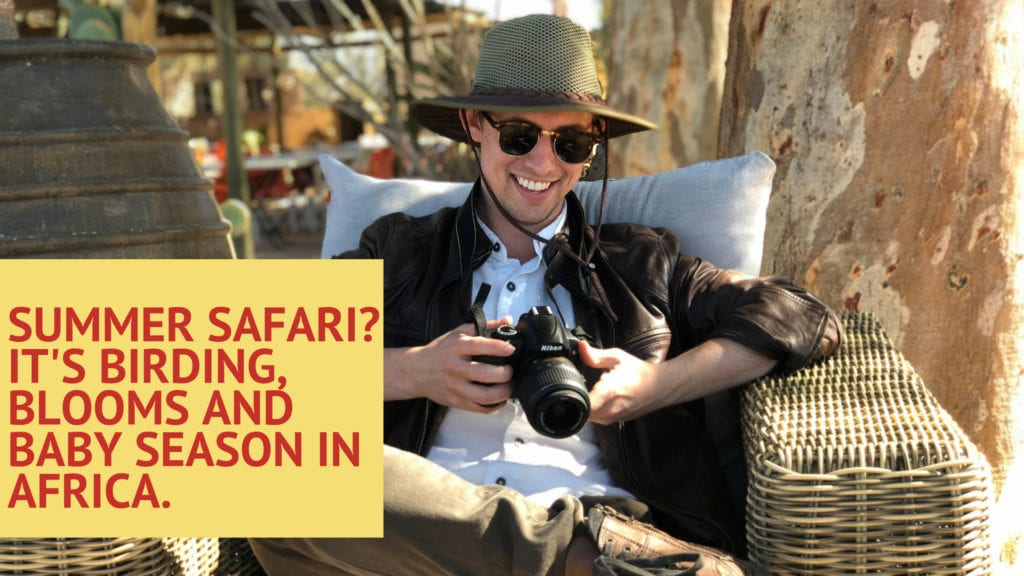
If birding is your bliss, then summer is your season. Migratory birds return adding song and color, filling Africa with spectacular breeding plumage.
And there is more… as soon as the rains come, the baby animals follow. Who can resist a miniature version of our favorite full-size creatures? Photographers, avid game spotters, general safari goers and of course predators, all revel in the advent of the young.
To make everything even better all the birds and the babies just happen to cavort about in the season when Africa is bursting with flowers as well.
Whatever your motivation, summer should be a serious consideration the next time you plan a Safari. Here are all the bountiful highlights of the warmer months on the wild continent.

Birds to Twitch for
A roll call of Africa’s best:
Vibrant kingfishers, vocal cuckoos, iridescent bee-eaters, grey-crowned cranes, Pel’s fishing-owl, red-necked falcon, African finfoot, hamerkop, secretary bird, guineafowl (2 species), mousebirds (3 species), turacos (Louries) (5 species), woodhoopoes, ground hornbills, African barbets, sugarbirds (2 endemic species)
Botswana
Combining desert with an inland delta, Botswana literally covers the spectrum of extreme habitats with the inhabitants to match all with the bonus of being an untouched wilderness.
Kenya
A vast geographical range with a variety of climates and landscapes gives Kenya the second highest number of bird species in Africa. It also achieved the world record ‘bird watch’ with 342 species seen in 24 hours in 1986 and held onto the record until 2015—when Ecuador finally claimed a new ‘Big Day’ record.
Malawi
With many rare bird species, the country’s water and forest habitats hold highlights such as the almost endemic Malawi batis, east coast akalat, and white-winged apalis.
Mozambique
Stretched out along the Indian Ocean coastline, Mozambique offers migrant coastal waders in the south and an incomplete ornithological record of bays and island in the north.
Namibia
From November to April migrants visit Namibia, adding to the native inland species. The rich, cold ocean attracts a large population of coastal birds, and during the summer food is plentiful, with species boasting colorful breeding plumage.
Rwanda
When you are not tracking gorillas, (or if they are being a little shy and making you wait) then you should take the time to find the Albertine Rift’s endemic birds. This tiny country has over 600 species and is perfect for birding. Volcanoes National Park alone has 125 different bird species.
South Africa
In the Cape, with its tremendous amount of flora, birders are sure to see many of the country’s birds. Here, birders can find the highest number of endemic bird species in mainland Africa, and South Africa also has an impressive number of birdwatchers and resources.
Tanzania
Much ornithological research has been carried out in Tanzania recently, and the country has a host of endemic, near-endemic and specialty birds. Reports of sightings of rare Denham’s bustard, the endangered blue swallow, mountain marsh widow, Njombe cisticola and Kipengere seedeater. European White Storks and other species of Storks from Scandinavian countries via West Africa rest in the Kitula plateau, migrating here to brood on their way, as they fly across the European and African continents between Cape Town and Northern Europe every year.
Zambia
A perfect mix of south, east and central African birds, the emerald season between November and March, when foliage is dense, and insects are thriving is excellent for birding. At this time the palearctic and intra-African migrants also visit.
 Beautiful Blooms
Beautiful Blooms
The Cape
Proteas, orchids, ericas and carnivorous sundew plants. And the fynbos also produces oddities from the crimson candelabra flowers that detach and roll along with the wind, to the orange-flowered and not-at-all-potent wild marijuana plants.
Kruger Park
Look out for trumpet-shaped Devil’s Thorn, golden flame-lily, spiny Kudu lily, Krantz Aloe, sharply toothed Lebombo Aloe, Leopard Orchid in the branches of a tree, lucky bean creeper with its beautiful seeds that are used in jewelry throughout Africa, wispy monkey’s tail, mountain aloe, bell-shaped river crinum, fluffy river Vernonia, water hyacinth, wild hibiscus, wild foxglove and wild 4-angled dagga.
The Kalahari is bursting with flowers in the midst of several hues of green. Namibia is suddenly a vibrant floral display with rivers briefly in full flow, Zimbabwe and Zambia are a kaleidoscope of floral displays, and in Botswana, the grazers are drawn onto the open plains as the rains transform everything from desert to delta.
Tanzania
On the Serengeti plains look out for the El Nino flower and the naughty (it is an invasive species) but delicately pretty Mexican poppy. The locals know the Kitula plateau as the Garden of God. Home to 400 plant species and 350 species of vascular plants, including 45 varieties of terrestrial endemic orchids, which erupt into a riotous wildflower display of breathtaking scale and diversity during the primary rainy season of late November to April, as well as lilies and fields of daisies.
Rwanda
One of the oldest mountain forest areas in Africa is in Nyungwe National park in the west of the country between Butare and Lake Kivu. The park, crisscrossed by waterfalls and mountain rivers, is situated near the foothills of the Great Rift Valley and crosses the country with high crests of up to 3.000 m. Several hundreds of flowering plants, 200 tree species, and beautiful endemic orchids dominate the primary vegetation. The flowers share their home with Colobus monkeys, over 500 chimpanzees, 175 bird species and 200 butterflies.

